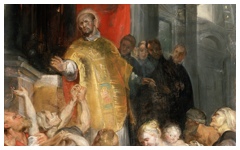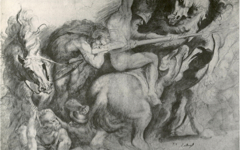Rubens’ Perseus Freeing Andromeda (c. 1622)
In this mythological scene of Perseus freeing the beautiful Andromeda from her chains Rubens has, in essence, depicted himself as Perseus “painting” her nude.
Perseus is more than an alter ego because not only does he have the red hair and beard Rubens was famous for (his name means redness in Latin as well) but he is posed like a painter. Perseus’ left arm steadies himself against his imagined canvas while his right arm is posed as though “drawing” Andromeda’s torso with a piece of chalk.
Andromeda is Perseus' “work of art” which is why one art historian has described her figure as “delicately sculpted in the bright light” without knowing why her figure looks so sculpted or why it seems lit by a different light. She is his “painting” so is lit from within it. Andromeda is both Rubens' muse and a female reflection of himself, red-haired too. Inside his mind she is nude and a perfect form, divinely created. That is why she is more rounded and real than the painter’s dressed figure in this ever-changing and illusory world.

Left: Detail of Rubens' Perseus Freeing Andromeda
Right: Picasso, Detail of a sketch for Guernica
Click image to enlarge.
The winged horse Pegasus waits patiently behind “the artist” (far left). Legend has it that Pegasus, foaled by the Gorgon Medusa, was so fertile that wherever he placed a foreleg a spring gushed forth. Pegasus symbolizes Rubens' poetic inspiration. His symbolism is so important that Picasso stopped signing P. P. Ruiz in order to use Picasso, his mother's name, alone. Why? Pegasus in Spanish is Pegaso, a sound very like Picasso. No art historian has ever recognized this before, word-play that changes the meaning of Picasso's curtain for Parade and Guernica too where Pegaso appeared in the initial sketches (near left).
Click next thumbnail to continue
The rocky and crevassed ground resembles the bases of Michelangelo’s sculptures and the ground in his painted scenes too. I have long imagined that these rocky formations resemble the serpentine crevasses of the cerebral cortex which is why, perhaps, the main image rests on them. Is it coincidence that the mostly unseen monster who guarded Andromeda appears beneath these rocks, perhaps representing elements of the artist’s sub-conscious wisdom, literally below the mind? Perseus with Andromeda would then represent the rational order of divine harmony, androgynous as a couple and free.
It is worth noting that Sigmund Freud turned knowledge of the mind into a science through classification but many of his ideas were already in existence long before. Harold Bloom, for instance, has claimed that there is nothing about the mind explained by Freud that did not already exist in Shakespeare. Why not in art, too?
As in images by Picasso and many others, the poetic subject of Rubens painting is not what we first think. Critics of art, from antiquity to the nineteenth century, typically praised artists for making objects and figures look so “real” that birds might peck at painted fruit or fools greet their friends. Little did they know, though, that here as elsewhere, we are all fooled unless, like other artists, we reach the poetic level underneath through the use of our own investigative powers.
More Works by Rubens
All art depicts the artist's mind. Here's one way you can see it.

Rubens’ Miracles of St. Ignatius of Loyola (c.1619)
Notes:
Original Publication Date on EPPH: 08 Jul 2011. | Updated: 0. © Simon Abrahams. Articles on this site are the copyright of Simon Abrahams. To use copyrighted material in print or other media for purposes beyond 'fair use', you must obtain permission from the copyright owner. Websites may link to this page without permission (please do) but may not reproduce the material on their own site without crediting Simon Abrahams and EPPH.






